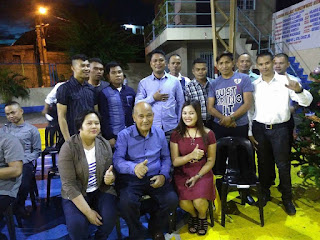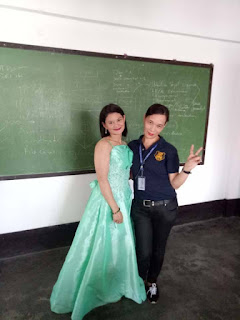CJC-JCOP CRIMINOLOGY INTERN
"ON THE JOB TRAINING"
SEPTEMBER 02, 2018
BUWAN NG WIKA 2018
AUGUST 27, 2018
LODORA VILLAGE, TUNASAN MUNTINLUPA CITY
CLASS ELECTED OFFICERS OATH TAKING CEREMONY
AY 2018-1019
JULY 01, 2018
OATH TAKING CEREMONY PREPARATION
BOODLE FIGHT
SUNDAY CLASS OFFICERS MEETING
JUNE 17, 2018
ROTC
APRIL 08, 2018
MARKSMANSHIP TRAINING
CHRISTMAS PARTY 2017
CJC 19TH FOUNDATION DAY
NOVEMBER 29, 2017
CJC-JCOP SPORTS FEST 2017
NOVEMBER 29, 2017
EVENT OF BUWAN NG WIKA YEAR 2017
MIXED MARTIAL ARTS KATA
HISTORY OF MARTIAL ARTS
Ancient peoples of all types engaged in fighting, war, and hunting.
Thus, each and every civilization subscribed to a version of martial arts or combat all their own. Still, most people think of Asia when they hear the term martial arts. Along with this, around the year 600 BC trade between India and China flourished. It is believed that during this time information regarding the Indian martial arts was passed onto the Chinese and vice versa.
According to legend, an Indian monk named BODHIDHARMA facilitated the transmission of Chan (China) or Zen (Japan) to China when he moved to southern China. His teachings lent a lot to martial arts philosophies like humility and restraint that continue even today. In fact, some have credited Bodhidharma with the initiation of Shaolin martial arts, though this assertion has been discredited by many.
Filipino martial arts (FMA) (Filipino: Sining sa pagtatanggol) refer to ancient Indianized and newer fighting methods devised in the Philippines. It incorporates elements from both Western and Eastern Martial Arts, the most popular forms of which are known as Arnis, and Eskrima. The intrinsic need for self-preservation was the genesis of these systems. Throughout the ages, invaders and evolving local conflict imposed new dynamics for combat in the islands now making up the Philippines.
The Filipino people developed battle skills as a direct result of an appreciation of their ever-changing circumstances. They learned often out of necessity how to prioritize, allocate and use common resources in combative situations. Filipinos have been heavily influenced by a phenomenon of cultural and linguistic mixture. Some of the specific mechanisms responsible for cultural and martial change extended from phenomena such as war, political and social systems, technology, trade and of course, simple practicality.
Types of Martial Arts
Generally, martial arts can be broken down into five distinct categories: Stand-up or striking styles, grappling styles, low impact styles , weapons based styles, and MMA (A Hybrid Sports Style).
Along with this, the emergence of MMA has caused quite a bit of mixing of styles in recent years to the point that a lot of dojos don't look quite the same as they used to. Regardless, below are some of the more well-known styles.
MODERN ARNIS
One of the characteristics of Filipino martial arts is the use of weapons from the very beginning of training and Modern Arnis is no exception. The primary weapon is the rattan stick, called a cane or baston (baton), which varies in size, but is usually about 28 inches (71 cm) in length. Both single and double stick techniques are taught, with an emphasis on the former; unarmed defenses against the stick and against bladed weapons (which the stick is sometimes taken to represent) are a part of the curriculum.
It is said that, originally, the cane was considered sacred by practitioners (Arnisador's), and therefore an Arnis practitioner was expected to hit his cane on the hand or forearm of his sparring partner and not at the latter's cane. This had the advantage of being the preferred method in actual combat, referred to as "defanging the snake", that is, making the opponent drop his weapon so that he is less of a threat. However, it discouraged many would-be practitioners who found this training too painful and injury-inducing. The result was that the Filipino martial arts became in danger of dying out; in most areas of the Philippines, Japanese martial arts such as Karate and Judo were much more popular than the indigenous systems. A principle of Modern Arnis, however, and in practical application, one would typically strike the hand or arm. The technique can be used empty-handed, where it is known as "limb destruction".
The training covers empty-hand self-defense (striking, locking, throwing, etc.) as well as the trademark single and double stick techniques of the Filipino martial arts. Other aspects of the art include espada y daga (sword and dagger fighting), sinawali (double stick weaving patterns), and tapi-tapi (locking drills with the stick). In addition to partner drills, Modern Arnis includes the use of anyo (KATA), solo forms both with and without the stick. Emphasis is placed on fitting the art in with a student's previous training ("the art within your art"), smoothly reacting to changing situations in the fight ("the flow"), and countering the opponent's attempt to counter strikes directed at him ("tapi-tapi"). Practitioners are called arnisadors or Modern Arnis players.
SIKARAN MARTIAL ART
SIKARAN - Philippines Martial Arts Style
Sikaran is a Filipino Martial Arts said to have originated in Tagalog region. Here, opponents for sport or for combat try to engage each other using kicks that mimic that of the farm animals and focused almost exclusively on Kicking. Hands and arms are only used for blocking. The signature move for Sikaran is the Biakid kick or “dragon whiplash”. This kick is similar to a Spinning hook kick. However, Sikaran users will frequently target the back of their opponent's head with this kick. In contrast, other martial arts target mainly the side of the head with this type of spinning kick.
According to Seletaria Sikaran-Arnis, "Sikaran is an ancient Philippine art of kick fighting. It is a Tagalog word that connotes “Kicking.” Tagalog is the most commonly used dialect in the Philippines and adopted as the national language of the country officially known as Pilipino. Sikaran is a coined word derived from the root word sikad (kick)."
KUNGKADO MARTIAL ART
KUNGKADO is a scientific combination of full contact freestyle martial arts techniques. It involves full contact karate, combat aikido, freestyle taekwondo and hard and soft kung fu that use 27 Chinese martial arts weapons such as Swords, Baton, Arnis, Nunchaks, Bo-Stuff, Tsai, Tonfa, 3 sectional sticks and even the 7 sectional sticks. Kungkado has Korean and Chinese martial arts origin.
Korean Martial Art - TANG SOO DO One of the origins of KUNGKADO, a traditional Korean martial art. Tangsudo means “the way of Chinese hands” or “the way of the Hand of China.” It concentrated on the discipline and the practice of forms and the orders of self-defense. Master Hwang Ki, the founder of this art, says that Tangsudo also derived form Subak (an older Korean martial art). Japanese karate and Chinese martial art has influenced Tangsudo.
Chinese Martial Art - KUNG FU, WUSHU and TAI CHI CHUAN
Another origin of KUNGKADO is the Chinese martial art namely Kung fu, Wushu and Tai Chi. Kung fu or gongfu is a western term used to describe Chinese martial arts. Chinese Martial Arts always emphasize a basic skill, such as strength training, staff sparring, fencing, and eight methods of Shaolin. All of these methods are very effective to be an expert in Chinese Martial Arts. According to some Chinese experts, the martial arts of China are the ancestor of all types of martial arts practiced in Japan, Korea, and Tibet. Many different techniques derived from the arts of China. Its art have been very influential on Martial arts practised across the globe. The term Kung fu was not popular until the 20th century. It was first reported by the French Jesuit missionary Jean Joseph Marie Amiot in the 18th century, until it became popular in the late 1960s because of Bruce Lee. On the other hand, Tai chi is a soft-style Chinese martial art. The teachings are intended to help people become harmonized with them and find an internal balance.
Dactyloscopy
FINGERPRINT
HENRY CLASSIFICATION SYSTEM
DACTYLOGRAPHY STUDY OF FINGERPRINTS
SUMMARY
PRIMARY
Each finger has a definite numerical value when a WHORL type pattern is present.
The total of these values make up the Primary. The numerator is made up of the total
sum of the values present in the even numbered fingers (2,4,6,8,10) PLUS One. The denominator
is made up of the values present in the odd numbered fingers (1,3,5,7,9) PLUS One.
SECONDARY
SMALLER LETTER GROUP
SUB-SECONDARY
MAJOR
The secondary is composed of the pattern types present in the INDEX fingers (2 and 7).
The number two finger is used as the numerator and the number seven finger is used as the
denominator. The Secondary classification is brought up to the classification line to the
right of the primary.
SMALLER LETTER GROUP
Prints with an ARCH (a), TENTED ARCH (t) or RADIAL LOOP (r) in any finger except index fingers constitute the Small Letter Group of the secondary Classification. Small letters consists of a,t and r only.
Small letters are brought up to the classification in their respective relative to the index
finger (2 and 7) when appearing in fingers 1,2,3,4,5,6,8,9,10.
All small letters must be indicated in the classification formula.
Dashes are used in the classification formula to indicate an ULNAR LOOP or a WHORL LOOP intervening between the index finger and the first small letter, or between two small letters.
When two or more small letter patterns of the same type appears together, they are indicated
as: 2a, 3a, 2t, 3t, 2r, or 3r.
SUB-SECONDARY
The subsecondary is taken from fingers 2,3,4 (numerator), and 7,8,9 (denominator).
The Subsecondary is brought up yo the classification line to the right of the secondary.
Definite values are assigned to the ridge counts in these fingers.
Whorl tracings are brought up as part of the Subsecondary.
A small letter to the right of the index finger eliminates the Subsecondary, with some exceptions.
The Major is taken from thumbs. The Major is brought up to the classification line to the left of the primary. Number six finger has only one set of values as a loop; it is always constant. Number one finger has two sets of values as a loop. Number six finger is used as the denominator, Number one finger is used as the numerator.
In a combination of loop and whorl, the first set of values is always used for the number one finger. if whorls are present in both thumbs, the tracings are used.
A small letter (a,t,r) present in either or both thumbs eliminates the Major.
Ridge Characteristic are known as level two details and are basic for individualization. Most of these individual characteristics were described by Sir Francis Galton, hence were sometimes called Galton Details. Other terms used include minutiae and typica.
FINAL
The Final is brought up to the right of the subsecondary. The Final is taken from number five finger if number five is a loop, either ulnar or radial. If number five is not a loop, the Final is taken from the number ten finger. if neither five nor ten is a loop, there is no Final, with some exceptions.
If the Final is taken from number five finger, it is brought up above the classification line. If the Final is taken from the number ten finger, it is brought up below the line.
If whorls are present in all fingers, the whorl in number five finger is counted and brought up as a Final. When counting whorls, always count as if they were ulnar loops. A whorl in the right hand is counted from left delta to core. In the left hand, count from right delta to core. When counting double loops a horizontal double loop is counted from the left delta to the nearest core. A vertical double loop is counted from the left delta to the upright loop. More than two cores, count from deltas, to core least number of ridges distant.
KEY
The Key is brought up to the classification line to the left of the major.
The Key is taken from the ridge count of the first loop appearing in the classification other than fingers five and ten. Either ulnar or radial loop may be used for the Key.
The Key is always brought up above the classification line, regardless of the finger used.
If there are no loops present there is no Key.
Ridge Characteristic are known as level two details and are basic for individualization. Most of these individual characteristics were described by Sir Francis Galton, hence were sometimes called Galton Details. Other terms used include minutiae and typica.
The Final is brought up to the right of the subsecondary. The Final is taken from number five finger if number five is a loop, either ulnar or radial. If number five is not a loop, the Final is taken from the number ten finger. if neither five nor ten is a loop, there is no Final, with some exceptions.
If the Final is taken from number five finger, it is brought up above the classification line. If the Final is taken from the number ten finger, it is brought up below the line.
If whorls are present in all fingers, the whorl in number five finger is counted and brought up as a Final. When counting whorls, always count as if they were ulnar loops. A whorl in the right hand is counted from left delta to core. In the left hand, count from right delta to core. When counting double loops a horizontal double loop is counted from the left delta to the nearest core. A vertical double loop is counted from the left delta to the upright loop. More than two cores, count from deltas, to core least number of ridges distant.
KEY
The Key is brought up to the classification line to the left of the major.
The Key is taken from the ridge count of the first loop appearing in the classification other than fingers five and ten. Either ulnar or radial loop may be used for the Key.
The Key is always brought up above the classification line, regardless of the finger used.
If there are no loops present there is no Key.
CJC TEAM BUILDING 2017
PANSOL LAGUNA
APRIL 23, 2017




















































































































































